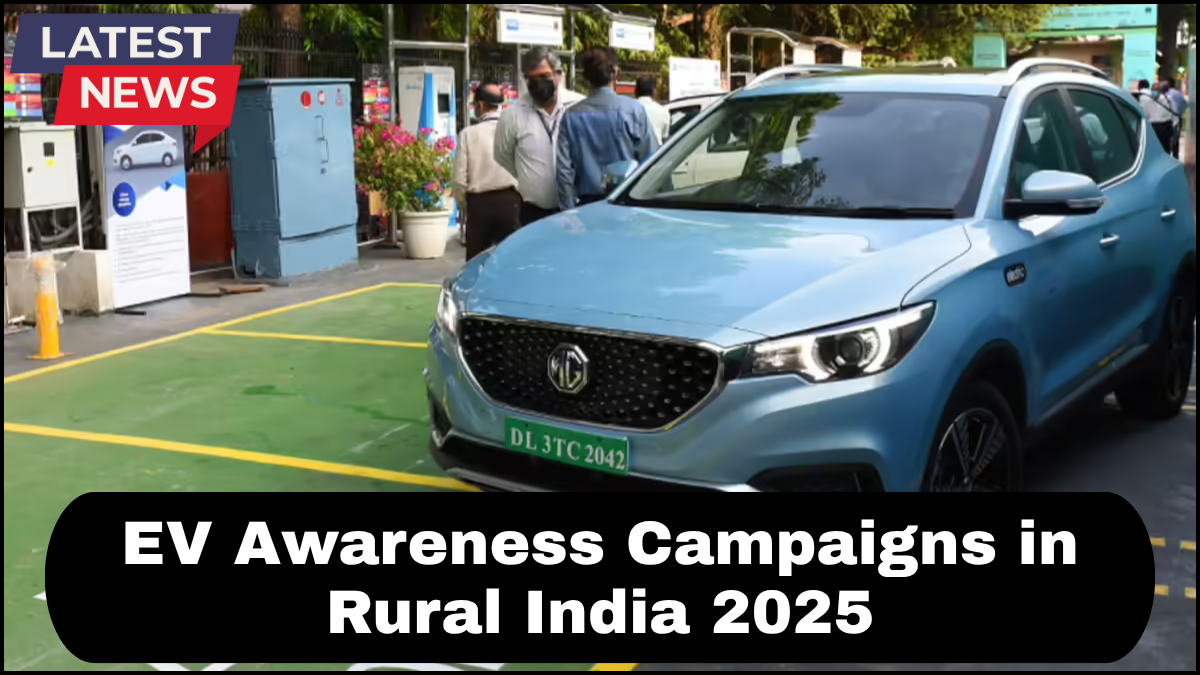In 2025, Rural EV Awareness Campaigns have become critical tools in India’s transition toward cleaner transportation. While urban centers have rapidly adopted electric vehicles (EVs), rural India—a vast and diverse segment of the population—still lags behind in both understanding and access. To bridge this gap, a nationwide movement is underway, targeting rural regions with educational initiatives, hands-on demonstrations, and policy-driven outreach.

Why Rural India Matters in India’s EV Journey
With over 65% of India’s population living in rural areas, any transition to electric mobility must include villages. These regions are not just passive observers—they’re integral to India’s energy future. However, multiple challenges such as lack of infrastructure, low awareness, and economic constraints have limited EV adoption in villages.
Enter the Rural EV Awareness Campaign 2025, a multifaceted strategy designed to address these barriers by directly engaging rural communities.
Core Elements of the Rural EV Awareness Campaign 2025
The 2025 campaign focuses on delivering knowledge, building trust, and making EVs a visible and relatable part of village life. Here’s how it’s structured:
1. Localized Educational Programs
Workshops and seminars are conducted in local dialects, simplifying complex terms like lithium-ion batteries, charging cycles, and maintenance into farmer-friendly language. Volunteers and local influencers play a key role in making these sessions more relatable.
2. Village EV Drive India Initiative
Under the Village EV Drive India initiative, mobile EV demo vans travel from village to village, showcasing different types of electric vehicles—from two-wheelers to small utility trucks. Locals can test drive these vehicles, see the charging process, and ask questions in real-time.
This approach not only demystifies electric mobility but builds confidence among potential rural buyers.
3. On-Ground Partnerships
The campaign is supported by partnerships between government agencies, EV manufacturers, NGOs, and panchayats (village councils). These collaborations help scale outreach efforts and provide follow-up support after awareness events.
4. Financial Literacy and Incentive Awareness
A major barrier to EV adoption in rural areas is cost perception. Through targeted financial literacy programs, villagers are educated about government subsidies, low-cost EV loan schemes, and how EVs can reduce fuel expenses over time.
Microfinance institutions and cooperative banks are brought into the conversation, making financing options more accessible.
5. Infrastructure Mapping and Solar Integration
The campaign also ties into local infrastructure planning. Portable and solar-powered charging stations are introduced in pilot villages, especially those off the grid. These low-cost innovations help communities see EVs as viable even without traditional power sources.
Impact and Case Studies
In regions like Bundelkhand, Maharashtra’s Vidarbha, and parts of Odisha, the 2025 Rural EV Awareness Campaign has shown tangible results. In one village in Rajasthan, an all-electric rickshaw fleet replaced diesel-powered ones within three months of the campaign’s visit, reducing monthly fuel costs by over 40%.
Another pilot in Tamil Nadu led to the creation of a women-led EV delivery cooperative using electric scooters, boosting local employment and sustainability.
Challenges That Still Remain
Despite progress, several hurdles persist:
-
Battery replacement costs are still high for rural consumers.
-
Repair and maintenance networks for EVs are limited in remote regions.
-
Cultural resistance exists in some areas, where people still associate EVs with urban elites.
These challenges highlight the need for ongoing engagement and scalable solutions beyond one-time campaigns.
What’s Next for 2025 and Beyond?
The next phase of the campaign involves:
-
Creating EV skill development centers in rural ITIs (Industrial Training Institutes).
-
Scaling the Village EV Drive India model to 10,000 villages.
-
Launching EV literacy through school curriculum modules to nurture awareness from a young age.
The momentum gained in 2025 is expected to feed into a longer-term rural electrification and clean mobility vision, with villagers no longer just passive recipients but active participants in India’s green transition.
Frequently Asked Questions (FAQs)
Q1: What is the Rural EV Awareness Campaign 2025?
A: It’s a nationwide initiative aimed at educating rural populations in India about electric vehicles through localized workshops, demo drives, and infrastructure support.
Q2: How does the Village EV Drive India help rural communities?
A: It brings mobile EV demo units directly to villages, allowing people to test electric vehicles, understand charging systems, and learn about financial benefits in a hands-on way.
Q3: Are EVs practical in villages with limited electricity?
A: Yes. Many campaigns include solar-powered charging solutions that work even in areas without a stable grid, making EVs more practical in rural contexts.
Q4: What types of EVs are being introduced in rural areas?
A: Two-wheelers, e-rickshaws, small utility vans, and electric tractors are part of the drive, selected based on rural transportation needs.
Q5: How can villagers afford EVs?
A: Awareness campaigns include financial education about subsidies, EMI plans, and micro-loans. These tools help make EVs affordable for lower-income households.
click here to learn more